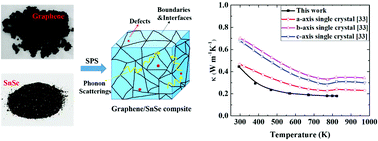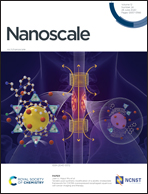Graphene inclusion induced ultralow thermal conductivity and improved figure of merit in p-type SnSe†
Abstract
The concept of composite material has been increasingly applied for the significant improvement in the thermoelectric performance because of the predictable effective medium properties and the unique interfacial correlated thermal and electrical transport mechanism. Herein, we report that the graphene inclusion can lead to a significant reduction in thermal conductivity and improve the overall thermoelectric figure-of-merit in SnSe. We demonstrate a systematic investigation on the microstructures and electrical and thermoelectric properties of the SnSe/graphene composite. HRTEM reveals the uniform distribution of graphene nanosheets in the SnSe matrix, forming a sharp interface with refined SnSe grain sizes and defects nearby the interfaces. Thermal conductivity decreases with graphene addition and can significantly reduce to as low as ∼0.18 W m−1 K−1, resulting in an enhanced figure of merit (ZT) of the SnSe/graphene composite by at least 50% compared with pristine SnSe. The significant reduction in thermal conductivity is attributed to the phonon scattering by densely distributed phase interfaces as well as defects and grain boundaries. The carbon element is also believed to potentially reduce long-range tin diffusion by acting as a confinement barrier to restrict heat and ion diffusion. Our work proves that the graphene secondary phase could enhance the ZT of the SnSe matrix, which might pave the way for achieving high-performance thermoelectric properties in carbon-induced composite materials.

- This article is part of the themed collection: Editor’s Choice: Thermoelectric nanostructures


 Please wait while we load your content...
Please wait while we load your content...